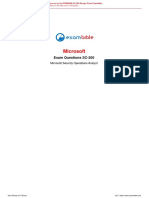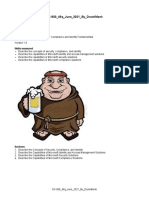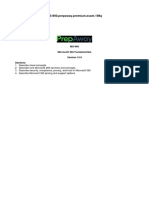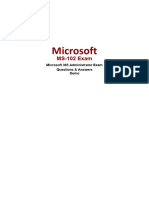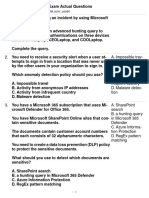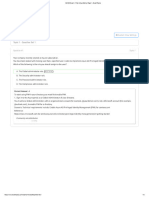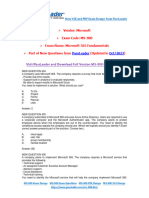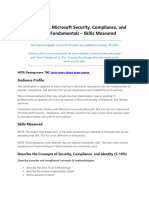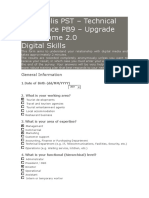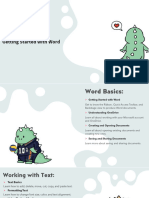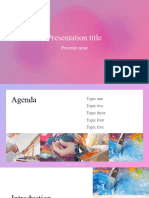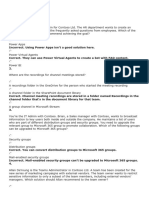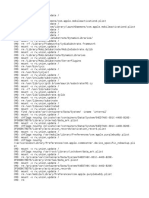sc-401 0
Uploaded by
Shiref Ragabsc-401 0
Uploaded by
Shiref RagabRecommend!!
Get the Full SC-401 dumps in VCE and PDF From SurePassExam
https://www.surepassexam.com/SC-401-exam-dumps.html (72 New Questions)
Microsoft
Exam Questions SC-401
Administering Information Security in Microsoft 365
Passing Certification Exams Made Easy visit - https://www.surepassexam.com
Recommend!! Get the Full SC-401 dumps in VCE and PDF From SurePassExam
https://www.surepassexam.com/SC-401-exam-dumps.html (72 New Questions)
NEW QUESTION 1
- (Topic 1)
You need to meet the retention requirement for the users' Microsoft 365 data. What is the minimum number of retention policies required to achieve the goal?
A. 1
B. 2
C. 3
D. 4
E. 6
Answer: B
Explanation:
The requirement states that all Microsoft 365 data for users must be retained for at least one year. In Microsoft 365, retention policies must be configured for each
type of data storage.
Step 1: Identifying Where Data is Stored
From the case study, users store data in the following locations: SharePoint Online sites
OneDrive accounts Exchange email Exchange public folders Teams chats
Teams channel messages
Since these locations fall under two broad categories: Microsoft Exchange data (Emails, Public folders)
SharePoint, OneDrive, and Teams data
Step 2: Required Retention Policies
* 1. A single retention policy can cover: SharePoint Online
OneDrive Microsoft Teams
* 2. A second retention policy is required for: Exchange (Emails & Public Folders)
Thus, the minimum number of retention policies required to meet the requirement is 2.
Microsoft 365 retention policies can be applied broadly across multiple services with just two policies:
One for Exchange & Public Folders
One for SharePoint, OneDrive, and Teams
There's no need for separate policies for each individual workload unless different retention durations are required, which is not stated in the requirement.
NEW QUESTION 2
DRAG DROP - (Topic 1)
You need to meet the technical requirements for the Site1 documents.
Which three actions should you perform in sequence? To answer, move the appropriate actions from the list of actions to the answer area and arrange them in the
correct order.
A. Mastered
B. Not Mastered
Answer: A
Explanation:
The goal is to automatically label documents in Site1 that contain credit card numbers. To achieve this, we need a sensitivity label with an auto-labeling policy
based on a sensitive
info type that detects credit card numbers.
Step 1: Create a Sensitive Info Type
A sensitive info type is needed to detect credit card numbers in documents.
Microsoft Purview includes built-in sensitive info types for credit card numbers, but we can also create a custom one if necessary.
Step 2: Create a Sensitivity Label
A sensitivity label is required to classify and protect documents containing sensitive information.
This label can apply encryption, watermarking, or access controls to credit card data.
Step 3: Create an Auto-Labeling Policy
An auto-labeling policy ensures that the sensitivity label is applied automatically when credit card numbers are detected in Site1.
Passing Certification Exams Made Easy visit - https://www.surepassexam.com
Recommend!! Get the Full SC-401 dumps in VCE and PDF From SurePassExam
https://www.surepassexam.com/SC-401-exam-dumps.html (72 New Questions)
This policy is configured to scan files and automatically apply the correct sensitivity label.
NEW QUESTION 3
- (Topic 1)
You need to meet the technical requirements for the creation of the sensitivity labels. To which user or users must you assign the Sensitivity Label Administrator
role?
A. Admin1 only
B. Admin1 and Admin4 only
C. Admin1 and Admin5 only
D. Admin1, Admin2, and Admin3 only
E. Admin1, Admin2, Admin4, and Admin5 only
Answer: D
Explanation:
To meet the requirement that all administrative users must be able to create Microsoft 365 sensitivity labels, we need to assign the Sensitivity Label Administrator
role to the correct users.
Sensitivity Label Administrator Role Responsibilities
This role allows users to:
Create and manage sensitivity labels in Microsoft Purview. Publish and configure auto-labeling policies.
Modify label encryption and content marking settings.
Review of Admin Roles from the Table:
Users that must be assigned the Sensitivity Label Administrator role: Admin2 (Compliance Data Administrator)
Admin3 (Compliance Administrator)
Admin1 (Global Reader) (should be assigned this role to fulfill the requirement that all admins can create labels).
NEW QUESTION 4
HOTSPOT - (Topic 1)
You are reviewing policies for the SharePoint Online environment.
For each of the following statements, select Yes if the statement is true. Otherwise, select No.
NOTE: Each correct selection is worth one point.
A. Mastered
Passing Certification Exams Made Easy visit - https://www.surepassexam.com
Recommend!! Get the Full SC-401 dumps in VCE and PDF From SurePassExam
https://www.surepassexam.com/SC-401-exam-dumps.html (72 New Questions)
B. Not Mastered
Answer: A
Explanation:
AI-generated content may be incorrect. Understanding Site4's Retention Policies:
Site4RetentionPolicy1 deletes items older than 2 years from creation. If a file was created on January 1, 2021, it would be deleted after January 1, 2023.
Site4RetentionPolicy2 retains files for 4 years from creation. If a file was created on January 1, 2021, it will be kept until January 1, 2025, but not deleted after that
(policy states "Do nothing").
Statement 1 - Yes, because Site4RetentionPolicy2 ensures files are retained for 4 years. Statement 2 - Yes, because Site4RetentionPolicy2 retains the file for 4
years (until January 1, 2025).
Statement 3 - No, because retention is only for 4 years (until January 1, 2025). After that, the policy does "nothing," meaning the file is no longer recoverable after
that period.
NEW QUESTION 5
HOTSPOT - (Topic 1)
How many files in Site2 can User1 and User2 access after you turn on DLPpolicy1? To answer, select the appropriate options in the answer area.
NOTE: Each correct selection is worth one point.
A. Mastered
B. Not Mastered
Answer: A
Explanation:
Understanding DLP Policy Impact on File Access
The DLP policy (DLPpolicy1) applies to Site2 and restricts access when: Content contains SWIFT Codes.
Instance count is 2 or more.
File Analysis (Based on SWIFT Codes Count)
Passing Certification Exams Made Easy visit - https://www.surepassexam.com
Recommend!! Get the Full SC-401 dumps in VCE and PDF From SurePassExam
https://www.surepassexam.com/SC-401-exam-dumps.html (72 New Questions)
Files that remain accessible (not restricted by DLP):
File1.docx (Contains only 1 SWIFT Code Below restriction threshold) User access after DLP policy is applied:
User1 (Site Owner):
Has higher privileges and can override DLP restrictions (through admin intervention). Can access 2 files (File1.docx + override access to another file).
User2 (Site Visitor):
Has read-only access but DLP blocks access to restricted files. Can only access 1 file (File1.docx), since all others are restricted.
NEW QUESTION 6
HOTSPOT - (Topic 1)
You need to meet the technical requirements for the confidential documents.
What should you create first, and what should you use for the detection method? To answer, select the appropriate options in the answer area.
NOTE: Each correct selection is worth one point.
A. Mastered
B. Not Mastered
Answer: A
Explanation:
To detect and protect confidential documents, we need a custom rule to identify project codes that start with 999 (since they are classified as confidential).
Box 1: A Sensitive Info Type (SIT) allows Microsoft Purview DLP policies to recognize structured data (e.g., project codes). DLP policies require a sensitive info
Passing Certification Exams Made Easy visit - https://www.surepassexam.com
Recommend!! Get the Full SC-401 dumps in VCE and PDF From SurePassExam
https://www.surepassexam.com/SC-401-exam-dumps.html (72 New Questions)
type to detect content based on patterns, keywords, or dictionary terms. A sensitivity label alone does not define detection logic—it is used for classification and
protection after content is identified.
Box 2: Since project codes follow a structured 10-digit pattern, we should use a Regular Expression (Regex) to match project codes that start with 999.
Example Regex pattern: 999\d{7}
This pattern detects a 10-digit number starting with "999".
NEW QUESTION 7
- (Topic 2)
You have a Microsoft 365 E5 tenant that has devices onboarded to Microsoft Defender for Endpoint as shown in the following table.
You plan to start using Microsoft 365 Endpoint data loss protection (Endpoint DLP). Which devices support Endpoint DLP?
A. Device1 only
B. Device1 and Device2 only
C. Device1 and Device4 only
D. Device1, Device2, and Device4 only
E. Device1, Device2, Device3, and Device4
Answer: B
Explanation:
Microsoft 365 Endpoint data loss prevention (Endpoint DLP) is supported only on Windows 10 and Windows 11 devices. It does not support macOS or iOS at this
time.
From the provided table:
Device1 (Windows 11) - Supported Device2 (Windows 10) - Supported Device3 (iOS) - Not supported Device4 (macOS) - Not supported
Thus, only Device1 and Device2 support Endpoint DLP.
NEW QUESTION 8
- (Topic 2)
You have a Microsoft 365 tenant.
You have a database that stores customer details. Each customer has a unique 13-digit identifier that consists of a fixed pattern of numbers and letters.
You need to implement a data loss prevention (DLP) solution that meets the following
requirements:
Email messages that contain a single customer identifier can be sent outside your company.
Email messages that contain two or more customer identifiers must be approved by the company's data privacy team.
Which two components should you include in the solution? Each correct answer presents part of the solution.
NOTE: Each correct selection is worth one point.
A. a sensitivity label
B. a sensitive information type
C. a DLP policy
D. a retention label
E. a mail flow rule
Answer: BC
Explanation:
You need to define a custom sensitive information type that recognizes the unique 13-digit identifier format for customer records. Microsoft Purview DLP policies
use these types to identify and protect sensitive data.
A Data Loss Prevention (DLP) policy is required to enforce the rules. It will allow emails with a single identifier but trigger an approval workflow when two or more
identifiers are detected.
NEW QUESTION 9
HOTSPOT - (Topic 2)
You have a Microsoft 365 E5 subscription that contains three DOCX files named File1, File2, and File3.
You create the sensitivity labels shown in the following table.
You apply the labels to the files as shown in the following table.
Passing Certification Exams Made Easy visit - https://www.surepassexam.com
Recommend!! Get the Full SC-401 dumps in VCE and PDF From SurePassExam
https://www.surepassexam.com/SC-401-exam-dumps.html (72 New Questions)
You ask Microsoft 365 Copilot to summarize the files, and you receive the results shown in the following table.
For each of the following statements, select Yes if the statement is true. Otherwise, select No.
NOTE: Each correct selection is worth one point.
A. Mastered
B. Not Mastered
Answer: A
Explanation:
Passing Certification Exams Made Easy visit - https://www.surepassexam.com
Recommend!! Get the Full SC-401 dumps in VCE and PDF From SurePassExam
https://www.surepassexam.com/SC-401-exam-dumps.html (72 New Questions)
NEW QUESTION 10
- (Topic 2)
Your company has a Microsoft 365 tenant.
The company performs annual employee assessments. The assessment results are recorded in a document named AssessmentTemplate.docx that is created by
using a Microsoft Word template. Copies of the employee assessments are sent to employees and their managers.
The assessment copies are stored in mailboxes, Microsoft SharePoint Online sites, and OneDrive folders. A copy of each assessment is also stored in a
SharePoint Online folder named Assessments.
You need to create a data loss prevention (DLP) policy that prevents the employee assessments from being emailed to external users. You will use a document
fingerprint to identify the assessment documents. The solution must minimize effort.
What should you include in the solution?
A. Create a fingerprint of AssessmentTemplate.docx.
B. Create a sensitive info type that uses Exact Data Match (EDM).
C. Import 100 sample documents from the Assessments folder to a seed folder.
D. Create a fingerprint of 100 sample documents in the Assessments folder.
Answer: A
Explanation:
Since all employee assessments follow a specific template (AssessmentTemplate.docx), the best way to identify these documents for Data Loss Prevention (DLP)
is to create a document fingerprint of that template.
Document fingerprinting allows Microsoft 365 DLP policies to recognize documents based on their structure and format, even when content inside varies (such as
different employee names and results). By creating a fingerprint of AssessmentTemplate.docx, any copy derived from that template will be automatically detected
by the DLP policy and blocked from being emailed externally.
Steps to implement:
Create a document fingerprint of AssessmentTemplate.docx using PowerShell and the Microsoft Purview compliance portal.
Apply a DLP policy to prevent external sharing of documents matching this fingerprint. Test the policy by attempting to email an assessment externally.
NEW QUESTION 10
- (Topic 2)
You have a Microsoft 365 E5 subscription. The subscription contains 500 devices that are onboarded to Microsoft Purview.
You select Activate Microsoft Purview Audit.
You need to ensure that you can track interactions between users and generative AI websites.
What should you deploy to the devices?
A. the Microsoft Purview extension
B. the Microsoft Purview Information Protection client
C. the Microsoft Defender Browser Protection extension
D. Endpoint analytics
Answer: A
Explanation:
To track interactions between users and generative AI websites in Microsoft Purview Audit, you need to deploy the Microsoft Purview browser extension to the
devices. This extension enables tracking of user activities on web-based applications, including AI-related tools like ChatGPT, Microsoft Copilot, and other
generative AI platforms.
Microsoft Purview extension provides visibility into browser-based activities, including AI tool usage, ensuring compliance and risk management within Microsoft
Purview. This extension works with Microsoft Edge and Google Chrome to track and log user interactions.
NEW QUESTION 15
- (Topic 2)
Your company has offices in multiple countries.
The company has a Microsoft 365 E5 subscription that uses Microsoft Purview insider risk management.
You plan to perform the following actions:
In a new country, open an office named Office1. Create a new user named User1.
Deploy insider risk management to Office1.
Add User1 to the Insider Risk Management Admins role group.
You need to ensure that User1 can perform insider risk management tasks for only the users and the devices in Office1.
What should you create first?
A. a dynamic device group
B. a dynamic user group
C. an administrative unit
D. a management group
Answer: C
Explanation:
To ensure User1 can perform insider risk management tasks only for the users and devices in Office1, the first step is to create an administrative unit in Microsoft
Entra ID (formerly Azure AD).
Administrative units allow you to scope permissions to specific users, devices, and locations. By creating an administrative unit for Office1 and assigning User1 to
the Insider Risk Management Admins role group within that unit, User1 will only have access to users and devices in Office1.
NEW QUESTION 18
- (Topic 2)
You have a Microsoft 365 E5 subscription that contains the users shown in the following table.
Passing Certification Exams Made Easy visit - https://www.surepassexam.com
Recommend!! Get the Full SC-401 dumps in VCE and PDF From SurePassExam
https://www.surepassexam.com/SC-401-exam-dumps.html (72 New Questions)
Which users will Microsoft Purview insider risk management flag as potential high-impact users?
A. User1 and User2 only
B. User2 and User3 only
C. User1, User2, and User3 only
D. User1, User2, User3, and User4
Answer: D
Explanation:
Microsoft Purview Insider Risk Management flags high-impact users based on various risk factors, including role, access to confidential data, and influence within
an organization. Let's analyze each user:
User1 (Regional Manager, assigned Reader role, manages department managers) Risk Factors:
Holds a managerial position (regional manager).
Manages multiple department managers, indicating organizational influence. Access to critical business information.
Flagged? -Yes (Managerial role and access to confidential data).
User2 (HR department manager, no Microsoft Entra roles, manages HR department users) Risk Factors:
Manages HR department users, meaning they likely handle sensitive employee data. HR roles are often considered high-risk due to access to personal and payroll
data.
Flagged? -Yes (HR role and access to sensitive employee data).
User3 (Developer, reports to User2, only user in compliance, assigned Compliance Administrator role)
Risk Factors:
Compliance Administrator role grants access to sensitive security and regulatory data. Only person in the compliance department, meaning they hold a critical role.
Potentially high impact on compliance and security settings.
Flagged? -Yes (Privileged Compliance Administrator role).
User4 (Assistant to User1, no Entra roles, handles confidential data on behalf of User1)
Risk Factors:
Handles a high volume of confidential data on behalf of a regional manager. Assistants with access to sensitive data are considered insider risk candidates.
Flagged? -Yes (High access to sensitive information).
Since all four users fit high-impact criteria (managerial roles, privileged compliance access, handling sensitive data), Microsoft Purview Insider Risk Management
will flag all of them.
NEW QUESTION 20
- (Topic 2)
You have a Microsoft 365 E5 subscription that contains a Microsoft SharePoint Online site named Site1.
You need to implement Microsoft Purview data lifecycle management. What should you create first?
A. a sensitivity label policy
B. a data loss prevention (DLP) policy
C. an auto-labeling policy
D. a retention label
Answer: D
Explanation:
To implement Microsoft Purview Data Lifecycle Management for SharePoint Online (Site1), you need to create a retention label first. Retention labels define how
Passing Certification Exams Made Easy visit - https://www.surepassexam.com
Recommend!! Get the Full SC-401 dumps in VCE and PDF From SurePassExam
https://www.surepassexam.com/SC-401-exam-dumps.html (72 New Questions)
long content should be retained or deleted based on compliance requirements. Once a retention label is created, it can be manually or automatically applied to
content in SharePoint Online, Exchange, OneDrive, and Teams. After creating a retention label, you can configure label policies to apply them to Site1 and other
locations.
NEW QUESTION 24
HOTSPOT - (Topic 2)
You have a Microsoft 365 E5 subscription that contains two Microsoft 365 groups named Group1 and Group2. Both groups use the following resources:
A group mailbox
Microsoft Teams channel messages
A Microsoft SharePoint Online teams site
You create the objects shown in the following table.
To which resources will AutoApply1 and Retention1 be applied? To answer, select the appropriate options in the answer area.
NOTE: Each correct selection is worth one point.
A. Mastered
B. Not Mastered
Answer: A
Explanation:
AutoApply1 is an auto-labeling policy that applies RLabel1 to Group1. Auto-labeling policies can apply retention labels across group mailboxes, SharePoint Online
sites, and Teams channel messages if they are configured for group resources.
Retention1 is a retention policy applied to Group2. Retention policies for Microsoft 365 groups apply to all group resources, including group mailboxes, SharePoint
Online teams sites, and Teams channel messages.
Since both AutoApply1 and Retention1 affect entire groups, they apply to all associated resources: group mailbox, SharePoint Online teams site, and Teams
channel messages.
NEW QUESTION 27
- (Topic 2)
You have a Microsoft 365 subscription.
You need to customize encrypted email for the subscription. The solution must meet the following requirements.
Ensure that when an encrypted email is sent, the email includes the company logo. Minimize administrative effort.
Which PowerShell cmdlet should you run?
A. Set-IRMConfiguration
B. Set-OMEConfiguration
C. Set-RMSTemplate
D. New-OMEConfiguration
Answer: B
Explanation:
To customize encrypted email in Microsoft 365, including adding a company logo, you need to modify the Office Message Encryption (OME) branding settings. The
Set- OMEConfiguration PowerShell cmdlet allows you to configure branding elements such as: Company logo
Passing Certification Exams Made Easy visit - https://www.surepassexam.com
Recommend!! Get the Full SC-401 dumps in VCE and PDF From SurePassExam
https://www.surepassexam.com/SC-401-exam-dumps.html (72 New Questions)
Custom text Background color
This cmdlet is used to update existing OME branding settings, ensuring that encrypted emails sent from your organization include the required customizations.
NEW QUESTION 31
HOTSPOT - (Topic 2)
You have a Microsoft 365 E5 subscription that has data loss prevention (DLP) implemented.
You plan to export DLP activity by using Activity explorer.
The exported file needs to display the sensitive info type detected for each DLP rule match. What should you do in Activity explorer before exporting the data, and
in which file format is the file exported? To answer, select the appropriate options in the answer area. NOTE: Each correct selection is worth one point.
A. Mastered
B. Not Mastered
Answer: A
Explanation:
Box 1: To include the sensitive info type detected for each DLP rule match, you need to add a custom column in Activity Explorer. This ensures that the exported
file contains specific details about the detected sensitive information types.
Box 2: DLP activity exports from Activity Explorer are always in CSV (Comma-Separated Values) format. This format allows for easy data analysis and reporting in
Excel or other data-processing tools.
NEW QUESTION 33
- (Topic 2)
You have a Microsoft 365 E5 subscription.
You need to prevent users from uploading data loss prevention (DLP)-protected documents to the following third-party websites:
web1.contoso.com web2.contoso.com
The solution must minimize administrative effort.
To what should you set the Service domains setting for Endpoint DLP?
A. *.contoso.com
B. contoso.com
C. web1.contoso.com and web2.contoso.com
D. web*.contoso.com
Answer: C
Explanation:
The Service domains setting in Microsoft 365 Endpoint Data Loss Prevention (Endpoint DLP) allows administrators to block or allow specific domains for file
uploads. The goal is to prevent users from uploading DLP-protected documents to web1.contoso.com and web2.contoso.com.
Setting the Service domains to "web1.contoso.com and web2.contoso.com" precisely targets the two specific third-party websites, minimizing administrative effort
while ensuring strict control.
NEW QUESTION 34
HOTSPOT - (Topic 2)
You have a Microsoft 365 E5 subscription that uses Microsoft Purview.
You need ensure that an incident will be generated when a user visits a phishing website. What should you do? To answer, select the appropriate options in the
answer area. NOTE: Each correct selection is worth one point.
Passing Certification Exams Made Easy visit - https://www.surepassexam.com
Recommend!! Get the Full SC-401 dumps in VCE and PDF From SurePassExam
https://www.surepassexam.com/SC-401-exam-dumps.html (72 New Questions)
A. Mastered
B. Not Mastered
Answer: A
Explanation:
Box 1: Insider Risk Management policies in Microsoft Purview can be configured to detect risky behavior, such as accessing phishing websites. These policies
monitor user activity, generate alerts, and help organizations investigate potential security threats.
Box 2: Microsoft Defender Browser Protection extension helps in detecting unsafe or phishing websites and integrating this detection with Insider Risk
Management policies. This extension works with Microsoft Edge and Google Chrome to identify risky browsing activity and trigger alerts.
NEW QUESTION 36
DRAG DROP - (Topic 2)
You have a Microsoft 365 E5 subscription that has data loss prevention (DLP) implemented.
You need to create a custom sensitive info type. The solution must meet the following requirements:
Match product serial numbers that contain a 10-character alphanumeric string.
Ensure that the abbreviation of SN appears within six characters of each product serial number.
Exclude a test serial number of 1111111111 from a match.
Which pattern settings should you configure for each requirement? To answer, drag the appropriate settings to the correct requirements. Each setting may be used
once, more than once, or not at all. You may need to drag the split bar between panes or scroll to view content.
NOTE: Each correct selection is worth one point.
A. Mastered
B. Not Mastered
Answer: A
Explanation:
Passing Certification Exams Made Easy visit - https://www.surepassexam.com
Recommend!! Get the Full SC-401 dumps in VCE and PDF From SurePassExam
https://www.surepassexam.com/SC-401-exam-dumps.html (72 New Questions)
NEW QUESTION 41
- (Topic 2)
You have a Microsoft 365 E5 subscription that contains a trainable classifier named Trainable1.
You plan to create the items shown in the following table.
Which items can use Trainable 1?
A. Label2 only
B. Label1 and Label2 only
C. Label1 and Policy1 only
D. Label2, Policy1, and DLP1 only
E. Label1, Label2, Policy1, and DLP1
Answer: D
Explanation:
A trainable classifier in Microsoft Purview is used to automatically identify and classify unstructured data based on content patterns. The classifier can be used in:
* 1. Retention Labels (Label2) Supported
Trainable classifiers can be linked to retention labels to automatically classify and apply retention policies to documents.
* 2. Retention Label Policies (Policy1) Supported
Retention label policies define how and where retention labels are applied, including automatically using trainable classifiers.
* 3. Data Loss Prevention (DLP) Policies (DLP1) Supported
Trainable classifiers can be used in DLP policies to detect and protect sensitive content automatically.
NEW QUESTION 43
- (Topic 2)
Note: This question is part of a series of questions that present the same scenario. Each question in the series contains a unique solution that might meet the
stated goals. Some question sets might have more than one correct solution, while others might not have a correct solution.
After you answer a question in this section, you will NOT be able to return to it. As a result, these questions will not appear in the review screen.
You have a Microsoft 365 tenant and 500 computers that run Windows 11. The computers are onboarded to Microsoft Purview.
You discover that a third-party application named Tailspin_scanner.exe accessed protected sensitive information on multiple computers. Tailspin_scanner.exe is
installed locally on the computers.
You need to block Tailspin_scanner.exe from accessing sensitive documents without preventing the application from accessing other documents.
Solution: From the Microsoft 365 Endpoint data loss prevention (Endpoint DLP) settings, you add a folder path to the file path exclusions.
Does this meet the goal?
A. Yes
B. No
Answer: B
Explanation:
Adding a folder path to the file path exclusions in Microsoft 365 Endpoint DLP does not prevent Tailspin_scanner.exe from accessing protected sensitive
information. Instead, it would exclude those files from DLP protection, which is not the intended outcome.
To block Tailspin_scanner.exe from accessing sensitive documents while allowing it to access other files, the correct solution is to use Microsoft Purview Endpoint
Data Loss Prevention (Endpoint DLP) and add Tailspin_scanner.exe to the Restricted Apps list.
Endpoint DLP allows you to block specific applications from accessing sensitive files while keeping general access available. Restricted Apps List in Endpoint DLP
Passing Certification Exams Made Easy visit - https://www.surepassexam.com
Recommend!! Get the Full SC-401 dumps in VCE and PDF From SurePassExam
https://www.surepassexam.com/SC-401-exam-dumps.html (72 New Questions)
ensures that Tailspin_scanner.exe cannot open, copy, or process protected documents, but it can still function normally for non-sensitive content.
NEW QUESTION 44
- (Topic 2)
You have a data loss prevention (DLP) policy configured for endpoints as shown in the following exhibit.
From a computer named Computer1, a user can sometimes upload files to cloud services and sometimes cannot. Other users experience the same issue.
What are two possible causes of the issue? Each correct answer presents a complete solution.
NOTE: Each correct selection is worth one point.
A. The unallowed browsers in the Microsoft 365 Endpoint data loss prevention (Endpoint DLP) settings are NOT configured.
B. There are file path exclusions in the Microsoft 365 Endpoint data loss prevention (Endpoint DLP) settings.
C. The Access by restricted apps action is set to Audit only.
D. The Copy to clipboard action is set to Audit only.
E. The computers are NOT onboarded to Microsoft Purview.
Answer: AB
Explanation:
The issue where users sometimes can upload files to cloud services and sometimes cannot suggests inconsistent enforcement of Endpoint DLP policies. This can
be caused by the unallowed browsers in the Microsoft 365 Endpoint DLP settings are NOT configured. Also, there are file path exclusions in the Microsoft 365
Endpoint DLP settings.
Endpoint DLP can block uploads only when using unallowed browsers. If unallowed browsers are not configured, users might be able to bypass restrictions by
switching to a different browser. This could explain why uploads sometimes work and sometimes don??t, depending on which browser is used.
File path exclusions allow certain files or folders to be exempt from DLP restrictions. If a specific file location is excluded, files stored there won??t trigger DLP
policies, leading to inconsistent behavior. This could result in some uploads being blocked while others are allowed.
NEW QUESTION 47
Passing Certification Exams Made Easy visit - https://www.surepassexam.com
Recommend!! Get the Full SC-401 dumps in VCE and PDF From SurePassExam
https://www.surepassexam.com/SC-401-exam-dumps.html (72 New Questions)
DRAG DROP - (Topic 2)
You need to create a trainable classifier that can be used as a condition in an auto-apply retention label policy.
Which three actions should you perform in sequence? To answer, move the appropriate actions from the list of actions to the answer area and arrange them in the
correct order.
A. Mastered
B. Not Mastered
Answer: A
Explanation:
To create a trainable classifier that can be used in an auto-apply retention label policy, you need to follow these key steps:
* 1. Create the trainable classifier
This is the first step where you define the classifier, specifying the types of content it should identify.
* 2. Test the trainable classifier
Before using the classifier in production, you need to validate its accuracy by testing it against sample documents to ensure it correctly classifies the intended data.
* 3. Publish the trainable classifier
Once testing is successful, you must publish the classifier so that it can be used in policies like auto-apply retention labels in Microsoft Purview.
NEW QUESTION 52
- (Topic 2)
Note: This question is part of a series of questions that present the same scenario. Each question in the series contains a unique solution that might meet the
stated goals. Some question sets might have more than one correct solution, while others might not have a correct solution.
After you answer a question in this section, you will NOT be able to return to it. As a result, these questions will not appear in the review screen.
You recently discovered that the developers at your company emailed Azure Storage Account keys in plain text to third parties.
You need to ensure that when Azure Storage Account keys are emailed, the emails are encrypted.
Solution: You create a data loss prevention (DLP) policy that has only the Exchange email location selected.
Does this meet the goal?
A. Yes
B. No
Answer: A
Explanation:
To ensure Azure Storage Account keys are encrypted when sent via email, you need a Data Loss Prevention (DLP) policy that detects Azure Storage Account
keys using a sensitive information type and automatically encrypts emails containing these keys.
A DLP policy with Exchange email as the only location meets this requirement because it identifies sensitive data in email messages and it applies protection
actions, such as encryption, blocking, or alerts.
NEW QUESTION 55
- (Topic 2)
Note: This question is part of a series of questions that present the same scenario. Each question in the series contains a unique solution that might meet the
stated goals. Some question sets might have more than one correct solution, while others might not have a correct solution.
After you answer a question in this section, you will NOT be able to return to it. As a result, these questions will not appear in the review screen.
You recently discovered that the developers at your company emailed Azure Storage Account keys in plain text to third parties.
You need to ensure that when Azure Storage Account keys are emailed, the emails are encrypted.
Solution: You configure a mail flow rule that matches the text patterns. Does this meet the goal?
A. Yes
B. No
Passing Certification Exams Made Easy visit - https://www.surepassexam.com
Recommend!! Get the Full SC-401 dumps in VCE and PDF From SurePassExam
https://www.surepassexam.com/SC-401-exam-dumps.html (72 New Questions)
Answer: B
Explanation:
To ensure Azure Storage Account keys are encrypted when sent via email, you need a Data Loss Prevention (DLP) policy that detects Azure Storage Account
keys using a sensitive information type and automatically encrypts emails containing these keys.
Text patterns in mail flow rules are not as reliable as sensitive information types in DLP. Mail flow rules lack advanced content detection and machine learning-
based classification, making them less effective than DLP.
NEW QUESTION 60
- (Topic 2)
You have Microsoft 365 E5 subscription.
You create two alert policies named Policy1 and Policy2 that will be triggered at the times shown in the following table.
How many alerts will be added to the Microsoft Purview portal?
A. 2
B. 3
C. 4
D. 5
E. 6
Answer: D
Explanation:
In Microsoft Purview, when multiple alert policies trigger alerts, duplicate alerts within a short period (typically 5 minutes) may be suppressed to avoid redundancy.
Step-by-step Analysis:
Policy1 at 10:00:04 is ignored because Policy1 already triggered at 10:00:00, and it's within 5 minutes.
Policy2 at 10:00:31 is ignored because Policy2 already triggered at 10:00:03, and it's within 5 minutes.
Policy1 at 10:01:01 is a new alert because it's over 1 minute after the previous Policy1 alert.
Policy1 at 10:04:45 is a new alert because it's over 3 minutes after the previous Policy1 alert.
NEW QUESTION 64
- (Topic 2)
You have Microsoft 365 E5 subscription that uses data loss prevention (DLP) to protect sensitive information.
You have a document named Form.docx.
You plan to use PowerShell to create a document fingerprint based on Form.docx. You need to first connect to the subscription.
Which cmdlet should you run?
Passing Certification Exams Made Easy visit - https://www.surepassexam.com
Recommend!! Get the Full SC-401 dumps in VCE and PDF From SurePassExam
https://www.surepassexam.com/SC-401-exam-dumps.html (72 New Questions)
A. Connect-IPPSSession
B. Connect-SPOService
C. Connect-ExchangeOnline
D. Connect-MgGraph
Answer: A
Explanation:
To create a document fingerprint in Microsoft 365 Data Loss Prevention (DLP), you need to use PowerShell for Microsoft Purview. The correct cmdlet to connect to
the Microsoft 365 Security & Compliance Center (where DLP policies are managed) is Connect- IPPSSession. This cmdlet establishes a PowerShell session to
manage DLP policies, compliance settings, and document fingerprinting.
NEW QUESTION 69
- (Topic 2)
Note: This question is part of a series of questions that present the same scenario. Each question in the series contains a unique solution that might meet the
stated goals. Some question sets might have more than one correct solution, while others might not have a correct solution.
After you answer a question in this section, you will NOT be able to return to it. As a result, these questions will not appear in the review screen.
You have a Microsoft 365 tenant and 500 computers that run Windows 11. The computers are onboarded to Microsoft Purview.
You discover that a third-party application named Tailspin_scanner.exe accessed protected sensitive information on multiple computers. Tailspin_scanner.exe is
installed locally on the computers.
You need to block Tailspin_scanner.exe from accessing sensitive documents without preventing the application from accessing other documents.
Solution: From the Microsoft Defender for Cloud Apps, you mark the application as Unsanctioned.
Does this meet the goal?
A. Yes
B. No
Answer: B
Explanation:
Marking Tailspin_scanner.exe as "Unsanctioned" in Microsoft Defender for Cloud Apps only blocks its usage in cloud-based activities (such as accessing
SharePoint, OneDrive, or Exchange Online). However, it does not prevent a locally installed application on Windows 11 devices from accessing sensitive files.
To block Tailspin_scanner.exe from accessing sensitive documents while allowing it to access other files, the correct solution is to use Microsoft Purview Endpoint
Data Loss Prevention (Endpoint DLP) and add Tailspin_scanner.exe to the Restricted Apps list.
Endpoint DLP allows you to block specific applications from accessing sensitive files while keeping general access available. Restricted Apps List in Endpoint DLP
ensures that Tailspin_scanner.exe cannot open, copy, or process protected documents, but it can still function normally for non-sensitive content.
NEW QUESTION 73
- (Topic 2)
Note: This question is part of a series of questions that present the same scenario. Each question in the series contains a unique solution that might meet the
stated goals. Some question sets might have more than one correct solution, while others might not have a correct solution.
After you answer a question in this section, you will NOT be able to return to it. As a result, these questions will not appear in the review screen.
You have a Microsoft 365 subscription.
You have a user named User1. Several users have full access to the mailbox of User1. Some email messages sent to User1 appear to have been read and
deleted before the user viewed them.
When you search the audit log in the Microsoft Purview portal to identify who signed in to the mailbox of User1, the results are blank.
You need to ensure that you can view future sign-ins to the mailbox of User1. Solution: You run the Set-AdminAuditLogConfig -AdminAuditLogEnabled $true -
AdminAuditLogCmdlets *Mailbox* command. Does that meet the goal?
A. Yes
B. No
Answer: B
Explanation:
The Set-AdminAuditLogConfig -AdminAuditLogEnabled $true -AdminAuditLogCmdlets
*Mailbox* command is incorrect. This enables admin audit logging, which tracks changes to mailbox configurations (e.g., mailbox settings updates), not user
activity inside the mailbox.
NEW QUESTION 74
HOTSPOT - (Topic 2)
You have a Microsoft 365 E5 tenant that contains a sensitivity label named label1. You plan to enable co-authoring for encrypted files.
You need to ensure that files that have label1 applied support co-authoring.
Which two settings should you modify? To answer, select the settings in the answer area. NOTE: Each correct selection is worth one point.
Passing Certification Exams Made Easy visit - https://www.surepassexam.com
Recommend!! Get the Full SC-401 dumps in VCE and PDF From SurePassExam
https://www.surepassexam.com/SC-401-exam-dumps.html (72 New Questions)
Passing Certification Exams Made Easy visit - https://www.surepassexam.com
Recommend!! Get the Full SC-401 dumps in VCE and PDF From SurePassExam
https://www.surepassexam.com/SC-401-exam-dumps.html (72 New Questions)
A. Mastered
B. Not Mastered
Answer: A
Explanation:
C:\Users\Waqas Shahid\Desktop\Mudassir\Untitled.jpg
NEW QUESTION 78
HOTSPOT - (Topic 2)
You have a Microsoft 365 E5 subscription.
You receive the data loss prevention (DLP) alert shown in the following exhibit.
Passing Certification Exams Made Easy visit - https://www.surepassexam.com
Recommend!! Get the Full SC-401 dumps in VCE and PDF From SurePassExam
https://www.surepassexam.com/SC-401-exam-dumps.html (72 New Questions)
Passing Certification Exams Made Easy visit - https://www.surepassexam.com
Recommend!! Get the Full SC-401 dumps in VCE and PDF From SurePassExam
https://www.surepassexam.com/SC-401-exam-dumps.html (72 New Questions)
Use the drop-down menus to select the answer choice that completes each statement based on the information presented in the graphic.
NOTE: Each correct selection is worth one point.
A. Mastered
B. Not Mastered
Answer: A
Explanation:
NEW QUESTION 82
......
Passing Certification Exams Made Easy visit - https://www.surepassexam.com
Recommend!! Get the Full SC-401 dumps in VCE and PDF From SurePassExam
https://www.surepassexam.com/SC-401-exam-dumps.html (72 New Questions)
Thank You for Trying Our Product
We offer two products:
1st - We have Practice Tests Software with Actual Exam Questions
2nd - Questons and Answers in PDF Format
SC-401 Practice Exam Features:
* SC-401 Questions and Answers Updated Frequently
* SC-401 Practice Questions Verified by Expert Senior Certified Staff
* SC-401 Most Realistic Questions that Guarantee you a Pass on Your FirstTry
* SC-401 Practice Test Questions in Multiple Choice Formats and Updatesfor 1 Year
100% Actual & Verified — Instant Download, Please Click
Order The SC-401 Practice Test Here
Passing Certification Exams Made Easy visit - https://www.surepassexam.com
Powered by TCPDF (www.tcpdf.org)
You might also like
- SC-401 Microsoft Exam Practice QuestionsNo ratings yetSC-401 Microsoft Exam Practice Questions10 pages
- Exam Questions SC-400: Microsoft Information Protection AdministratorNo ratings yetExam Questions SC-400: Microsoft Information Protection Administrator5 pages
- Microsoft SC-400 Exam Dumps & Practice QuestionsNo ratings yetMicrosoft SC-400 Exam Dumps & Practice Questions11 pages
- Microsoft Test-Inside sc-200 Dumps 2022-Oct-15 by Berg 94q VceNo ratings yetMicrosoft Test-Inside sc-200 Dumps 2022-Oct-15 by Berg 94q Vce9 pages
- SC-200 Microsoft Exam Questions and AnswersNo ratings yetSC-200 Microsoft Exam Questions and Answers8 pages
- Dumpsarena Reliable Exam Dumps For All CertificationsNo ratings yetDumpsarena Reliable Exam Dumps For All Certifications9 pages
- PassLeader - Microsoft 365 Administrator - ms-102.Dumps.274.Q&AsNo ratings yetPassLeader - Microsoft 365 Administrator - ms-102.Dumps.274.Q&As281 pages
- SC-900 Microsoft Updated Practice QuestionsNo ratings yetSC-900 Microsoft Updated Practice Questions15 pages
- MS-900 Dumps Microsoft 365 Fundamentals: 100% Valid and Newest Version MS-900 Questions & Answers Shared by Certleader100% (1)MS-900 Dumps Microsoft 365 Fundamentals: 100% Valid and Newest Version MS-900 Questions & Answers Shared by Certleader15 pages
- Website: Vce To PDF Converter: Facebook: Twitter:: Sc-300.Vceplus - Premium.Exam.52QNo ratings yetWebsite: Vce To PDF Converter: Facebook: Twitter:: Sc-300.Vceplus - Premium.Exam.52Q42 pages
- MS-102 Exam - Free Actual Q&As, Page 7 - ExamTopicsNo ratings yetMS-102 Exam - Free Actual Q&As, Page 7 - ExamTopics9 pages
- Microsoft MS-900 Exam Dumps & QuestionsNo ratings yetMicrosoft MS-900 Exam Dumps & Questions10 pages
- Microsoft - Testkings.az 801.PDF.2024 May 27.by - Moses.83q.vceNo ratings yetMicrosoft - Testkings.az 801.PDF.2024 May 27.by - Moses.83q.vce13 pages
- AZ-500 Exam - Free Actual Q&as, Page 1 - ExamTopicsNo ratings yetAZ-500 Exam - Free Actual Q&as, Page 1 - ExamTopics6 pages
- (Oct-2023) New PassLeader MS-900 Exam DumpsNo ratings yet(Oct-2023) New PassLeader MS-900 Exam Dumps7 pages
- DumpsBoss: Study Materials That Actually Help You PassNo ratings yetDumpsBoss: Study Materials That Actually Help You Pass9 pages
- SC-200 Microsoft Exam Questions and Answers 8No ratings yetSC-200 Microsoft Exam Questions and Answers 87 pages
- SC 200 Microsoft Azure Security Operations Analyst Exam Study Guide PDFNo ratings yetSC 200 Microsoft Azure Security Operations Analyst Exam Study Guide PDF20 pages
- Exam SC 900 Microsoft Security Compliance and Identity Fundamentals Skills MeasuredNo ratings yetExam SC 900 Microsoft Security Compliance and Identity Fundamentals Skills Measured8 pages
- Microsoft AZ-104 Premium PDF - 2025 Dumps, Practice Questions & Study Guide (ExamHeist Verified For AZ-104 & Azure Exams)No ratings yetMicrosoft AZ-104 Premium PDF - 2025 Dumps, Practice Questions & Study Guide (ExamHeist Verified For AZ-104 & Azure Exams)70 pages
- MS-102 Exam - Free Actual Q&As, Page 1 - ExamTopics100% (1)MS-102 Exam - Free Actual Q&As, Page 1 - ExamTopics256 pages
- DP-900: Microsoft Azure Data Fundamentals Sample Questions: User Guide0% (1)DP-900: Microsoft Azure Data Fundamentals Sample Questions: User Guide21 pages
- FreeCram - Juniper - JN0 1102.v2021 08 24 - Q25No ratings yetFreeCram - Juniper - JN0 1102.v2021 08 24 - Q256 pages
- Certification Exams Realistic Questions Free For Limited TimeNo ratings yetCertification Exams Realistic Questions Free For Limited Time1 page
- (Apr-2024) New PassLeader MS-102 Exam DumpsNo ratings yet(Apr-2024) New PassLeader MS-102 Exam Dumps7 pages
- CIS Microsoft 365 Foundations Benchmark v2.0.0No ratings yetCIS Microsoft 365 Foundations Benchmark v2.0.0255 pages
- Windows 10 Pro Retail DVD Activation Key Inside 32 64 Bit Lifetime LicenseNo ratings yetWindows 10 Pro Retail DVD Activation Key Inside 32 64 Bit Lifetime License34 pages
- For Power BI Installation:: Get Data: To Get The Data From Different Sources Like CSV, Excel, Test, SQL, Access Etc..No ratings yetFor Power BI Installation:: Get Data: To Get The Data From Different Sources Like CSV, Excel, Test, SQL, Access Etc..11 pages














